Warren Haynes’ résumé would make even the most elite guitarist flush with envy: A 25-year tenure with the Allman Brothers, a successful solo career, stints working with the Grateful Dead, John Scofield, and Don Was, and a wide portfolio as a producer would all place him among his generation’s most productive players—even if he’d never teamed with fellow Allman bassist, the late Allen Woody, to form Gov’t Mule.
In the 23 years since the band’s inception, Haynes and his Mule mates—Danny Louis (keys, guitar, trumpet), Jorgen Carlsson (bass), and Matt Abts (drums)—have used American jam-rock as a launching pad to explore their unusual combination of virtuosity, fluent improvisation, strong songwriting, and soulful singing.
The band’s latest album, Revolution Come…Revolution Go delivers all of that and more, with a collection of songs that swings from the political (exemplified by the title cut and the album’s searing opener, “Stone Cold Rage”) to the personal. Revolution was primarily recorded in Austin and coproduced by Haynes and his longtime collaborator Gordie Johnson (who adds some tasty pedal steel to “Traveling Tune”). Other key contributors include Don Was (who coproduced two tracks) and Austin icon Jimmie Vaughan (“Burning Point”).
“We’re all really happy with the way this turned out,” Haynes says. “It’s the most diverse record we’ve ever made. The energy is really ‘live’ in the way the four of us play together. It’s very important to us that the interplay comes across, even in the more straight-ahead songs. As opposed to building things one instrument at a time, we’re really committed to maintaining this approach: recording live, keeping the solos from the live takes, and capturing band chemistry.”
I love that vocal quality.”
When we reached Haynes by phone, the band was preparing to take Revolution on the road. Yet despite a busy rehearsal schedule, he was generous with both his time and his insights into writing, producing, arranging, playing, and gear. While you’re reading, you can stream four songs from the album—“Stone Cold Rage,” “Sarah, Surrender,” “Pressure Under Fire,” and “Songs & Dreams.”
You started recording Revolution Come…Revolution Go on Election Day. Did the outcome influence the sessions?
We joked that it was going to be a different kind of record if everybody was wrong and Trump actually won [laughs]. And it definitely changed our perspective and the overall feeling of starting the record. The songs that had political connotations—and there are only a few, like “Stone Cold Rage”—had already been written. It just made us look at them differently. When you look back at the lyrical content, it’s just an observation that no matter who wins, approximately half the people in American will be pissed off about it. And it’s really more about the divide and the anger and the intensity that’s going on right now, which is more than at any time in my adult life. There’s a tongue-in-cheek aspect to it, but the music has an intensity that goes along with the message.
Did you arrange the song to match the lyrics or did the music suggest the message? What usually comes first?
Through the years, more of my songs have started with the lyrics, as opposed to a musical hook. But in the last five or six years, I’ve been making myself do the opposite—concentrate on writing music first and lyrics later—just so I don’t get stuck in a pattern. Also, when I look back, I realize most of the up-tempo songs start with music, and most of the mid-tempo and down-tempo songs start with the lyrics.
“Stone Cold Rage” started with that guitar riff in the very front. That’s the first thing I wrote. I had other little pieces here and there, and Danny wrote the instrumental section. He’d been playing that part in a different context, and I thought it would fit great in the middle of this song. We often do that—a riff winds up somewhere other than where we originally thought.
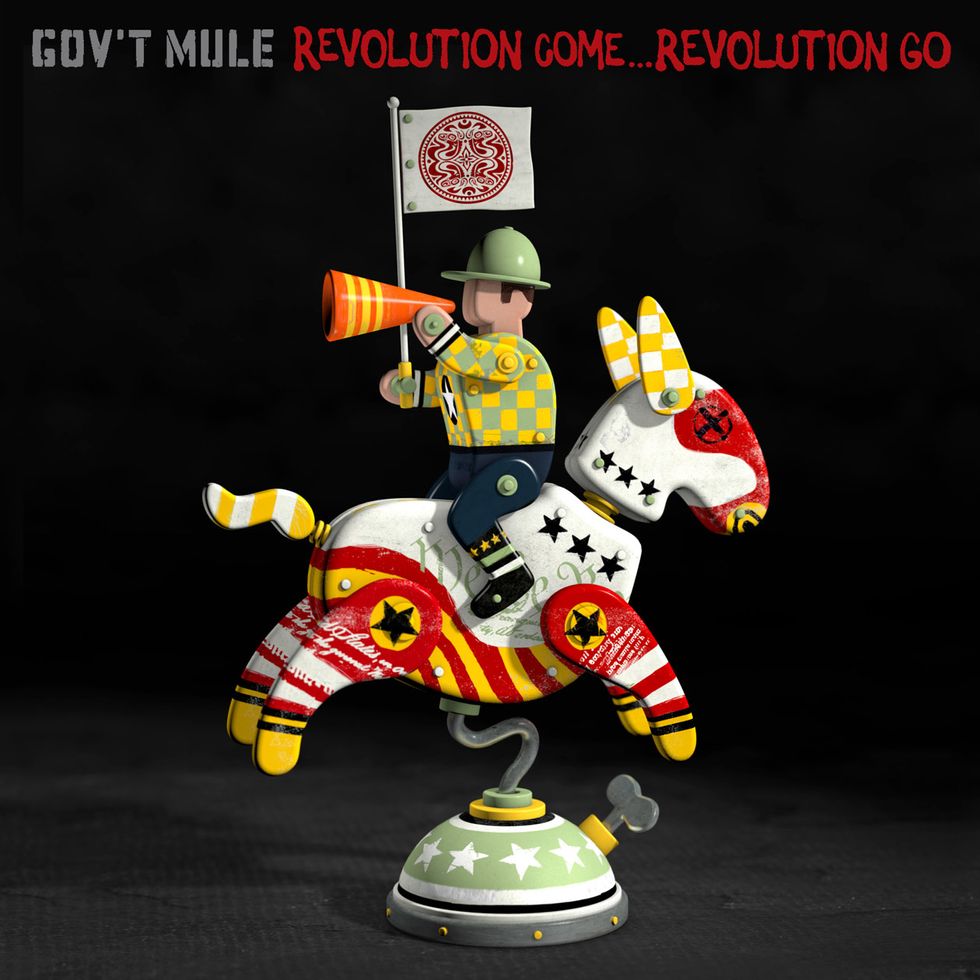
“It’s the most diverse record we’ve ever made,” says Haynes of the band’s 10th studio album. “The chemistry is really ‘live’ in the way the four of us play together.”
The guitar has a vocal quality, but then you’re also a singer. How does your role as a singer factor into your thinking in terms of guitar parts and tone?
If I’m improvising, hopefully I’m not thinking at all. But if I’m coming up with a melody or a hook line, sometimes the guitar and whatever amp you’re playing through inspires it. In the case of “Stone Cold Rage,” I wrote it on an SG, but I played it on a Telecaster, which is new for me. I never recorded a Tele on a Gov’t Mule song other than one little overdub on [Mule’s 1998 album] Dose. This was the first time I made a Telecaster my main guitar for a song, and I wound up using it for three songs.
Because I started singing before I started playing guitar, I’ve always been drawn toward guitar players who also sing or sound like they’re singing through their instruments. I love that vocal quality. Most of my favorite players, whether it’s guitar or any instrument, have that way of sounding like a singer. It goes back to gospel-blues phrasing and where you put the breath. But it also transfers over to jazz and any sort of music where the punctuation is very important—how short or long the lines are. Phrasing is such a tricky thing. We don’t think of it this way, but a lot of instrumental phrasing comes from singers, and singers have to take a breath. Where you take that breath is very important.
The music has such a live feel to it. Did you all record together in the same room?
Our normal recording process is to have everybody together in the same room looking at each other, and the majority of everything that winds up in the mix is live performance. Occasionally, we’ll overdub something. Since we’re talking about “Stone Cold Rage,” Danny played organ on the track and overdubbed clavinet, but sometimes, he’ll actually play two keyboards at once if it feels like the right thing. I played the middle guitar solo live on the take. Most of my guitar solos wind up being recorded live with the band. But the solo during the outro is an overdub because at the time I didn’t realize the song would need another solo at the end.
Aren’t you ever tempted to go with the layered overdub approach?
I keep going into each new record thinking I want to do more overdubs, so I can experiment more. But I always wind up keeping the performances I track with the band because the interplay is better. It’s a special conversational call-and-response among all of us. That’s more important to me than whether or not I played my best solo.
Plus, this is something I learned from [legendary producer] Tom Dowd a long time ago. I was fortunate enough to make four studio records and two live records with Tom. He said when the band sounds the best, you play your best solo. I once asked him, “Is it a coincidence that all my best solos are on the takes you wind up keeping?” And he said, “Have you ever thought that maybe it’s the other way around?” The best takes inspire you to play the best.
Photo by Jacob Blickenstaff
When you’re recording live in the studio, how do you make the tonal transitions from rhythm to lead?
All my effects run through a Bob Bradshaw switching system, so they’re bypassed when I’m not using them. It’s set up so I can use three different amps, all simultaneously or separately. In this case, I had a Homestead red head amp [a 100-watt head stocked with optional 6550 power tubes], which replaced my old Cesar Diaz. Homestead is a continuation of Diaz—it’s the same people. That’s my cleaner sound, which is not clean, but dirtied up like a really loud Fender. In the second spot, what I call the “big head” position, I run either my Soldano SLO-100—which has been drastically modified by Mike Soldano—or one of my Marshalls. And then I always use a small amp of some sort. Recently, I’ve been using an Alessandro recording amp, which only has a volume and tone control. I usually have it blended in with any other amps I’m using. Occasionally, I’ll even use it by itself, but most of the sounds are the Homestead or the Soldano with the Alessandro—or all three.
Do you use the same configuration live?
Live, it’s the two big heads, but I never use them at the same time. I haven’t yet used the small amp live, but I may because it’s such a cool sound. I know Stevie Ray Vaughan used to have an amp in the truck or downstairs in another room that was being miked, but so far I haven’t gone there.
Are all the amps isolated from one another?
I had the Alessandro right by me so I could feel it. It’s almost like a little monitor. It’s in the room, but it’s not loud enough to worry about bleeding into the drum mics, and there’s a gobo between it and the drums. The two 4x12 cabinets, which are being driven by the 100-watt heads, are in a separate room, next to each other, but with a little separation. Because they were in a big room, we could use both close and distance mics for the big amps. It gives us a lot of possible combinations.
On many solos, your overdrive has a rich vocal quality. Is that all from the amps or are you using pedals?
It’s usually from the amp. The Homestead has a midrange boost, and sometimes I’ll use that to get the sound you’re talking about. But sometimes I just turn the tone knobs down on my guitar. On “Revolution Come, Revolution Go,” I’m playing an SG with both pickups on, and one of the tone controls is almost all the way down.
Does having the small amp in the room help you get the touch you want on the guitar?
Absolutely. Even if you have a 100-watt amp turned up super loud, if you’re in another room with headphones, you’re not getting what it does when you’re standing next to it. So this helps recreate that without all the leakage problems.
I’m not a fan of recording with headphones, so having something I can feel and hear near me makes a big difference. I’ve done the last few records with a small amp. Before I started using the Alessandro, it was a Fender Pro Junior. I would even set it at my feet like a monitor. That way I can get feedback if I need it, and it feels more like a live performance.
Do you go into the studio with clear ideas about the guitar sounds or do you experiment once you’re in there?
Usually, we think about what worked on the last record and use that as a place to start. And of course, Gordie Johnson, whom I’ve worked with a lot, is really great in that department. We did five days of pre-production with Gordie, and I’d rely on him for input. While I was concentrating more on the arrangements, he’d be listening for what guitar and amp combinations worked, and he kept a log.
When you’re recording live as a band, do you need a lot of takes to get the keeper?
On “Stone Cold Rage,” we did maybe five takes because the song was new and it kept changing. I think we used a lot of the first take. Typically, the arrangement will be different from take to take. With some songs, we might go back and say “the intro up to the bridge was great on this take, but the solo’s better on the other take” and then put them together. We have no aversion to doing that.
The song “Sarah, Surrender” is quite a contrast sonically and emotionally to everything else on the record. How did it evolve?
It was the only song that was not recorded in Austin [at Arlyn Studios]. I wrote it after we were finished with the Austin sessions. We were all together in New York for the Beacon [Theater] shows, so I said, “Let’s go find a studio and see what happens.”
We set up, figured out the arrangement, learned it, got sounds, recorded it, added the background singers and percussion—all over the course of one long day. I was concentrating on singing, so I could drive the band with the vocal. The first thing that happened was Matt changed his original drum pattern and started playing this Al Green kind of thing. And that made me sing differently, which made what everyone was playing change, too. Since I was concentrating on singing, I played less guitar. And I realized that the beginning of the song and the second verse sounded really cool with just bass and drums and vocals. So I played a little bit of the intro, sang, and came back for certain sections. The organ was really driving the song. When it was done, I wanted to get a jazzy sound, so I overdubbed the solo using a 1958 Gretsch hollowbody jazz guitar that was a recent gift.
You’re celebrated for your lead work, but your rhythm playing is equally important to the band’s sound. How do you approach those parts?
It’s mostly based off what feels good while I’m singing. If I write a song with a rhythm guitar part that I think is cool but can’t play and sing at the same time, I usually try to modify the guitar part in a way that allows me to sing. In the long run, that’s usually better because if you can’t sing it and play it, it’s probably interfering with the vocal anyway. But that’s not always the case. In bands that I love, there’s often really cool rhythm guitar playing behind the singer that couldn’t coexist in one person—Jimi Hendrix being the rare exception. I love that, too.
Another contrast to the album’s main vibe is “Dreams & Songs.” What was the emotional point of departure on that one?
I wrote that song in Europe and I was at a really weird place emotionally. I’d found out I needed to have my gall bladder removed. So I got off the plane and went into the hospital. Although I wound up forgoing the surgery until I got home, it meant a day of absolute misery and then having to eat the blandest of bland food for the rest of the trip until I could get back and have the operation. I knew it was an easy procedure and I’d feel better after it was over, but I was in pain and I had not slept. I found myself writing, and “Dreams & Songs” was one of the pieces that came out of that. It’s a very reflective song written at an extremely emotional period.
It’s all positive now, because when I went back and looked at the lyric in the light of day—the part at the end about my son and about the future—it just all felt complete and organic. I wasn’t sure whether to save it for my next solo record or if it would be something for Gov’t Mule to interpret. When I showed it to the band, they were excited about putting their stamp on it. And then when [producer] Don Was got involved, he pulled a cool, emotional take out of us—which, incidentally, was the first take.
“Allen Woody and I used to say one performance is equal to 10 rehearsals,” says Haynes. “When you get onstage in front of an audience and you do something wrong, you never forget it.” Photo by Jordi Vidal
What’s it like working with him?
Don sits in the room with the band with headphones on, and he looks at us while we’re recording. We recorded two songs with him. The first was “Pressure Under Fire.” After we played take four, he said, “That sounds like a record.” Then we went in and listened to it, and we all loved how it sounded. And after take one of “Dreams & Songs,” he said, “That sounds like a record.” And we listened and went, “Wow, it’s really good!” Matt’s performance, Danny’s performance—everything just had the emotional connection to the song that it needed. So I was really glad we decided to make it a Gov’t Mule song.
Every Gov’t Mule album has about 70 percent songs that were obviously written for Gov’t Mule, and another 20 to 30 percent of songs that could have gone on one of my solo records, but wound up being interpreted by Gov’t Mule. That’s a balance we like—it makes our records more diverse.
When you’re producing, is it hard for you to let go of a song and declare it done?
I’m pretty good about closing the book and knowing that I’m happy with a song. That doesn’t mean I’m happy with every inch of a record—that’s definitely not the case—but I can usually tell when it’s final. But even then, it’s going to change over the next six months of playing it live. The real rarity, which we all hate, is when six months later you start looking at a song completely differently and it’s better than what you did in the studio. But that’s just part of it. It’s probably true of every rock ’n’ roll record ever made.
Do you do a lot of preproduction or do you write in the studio?
There are several songs on every Mule record that are written, arranged, and recorded all in the studio. And they usually turn out great. It’s nice to go in armed with a lot of songs and then open yourself up to the possibility of adding to them when you get there. It would be great to spend tons of time and money in the studio just trying everything over months at a time, but that’s an impossibility, so we have to be prepared when we get there. But I would say we’re less prepared than the average band [laughs].
You’ve done so much as a player, writer, producer, and singer. So how do you go further at this stage of your career, both in terms of your guitar technique and your mental approach?
Everybody looks at it differently. I think there’s a lot more music I haven’t touched on—whether it’s my own playing or the chord progressions or melodic harmonies. So I’ll make mental notes that I want to branch out and go a little further in different directions. Sometimes that will be coupled with experimenting with different sounds. The sounds I use in Gov’t Mule and that I used in the Allman Brothers were sounds I’d road-tested for years. They’re part of my voice and I’m very happy with them, but occasionally I think it’s nice to plug a different guitar into a different amp and just see what happens. That will usually influence me to play differently.
and just see what happens.”
With Gov’t Mule, we want each record to go some places we haven’t gone before. It doesn’t have to be complicated. Like when we made the decision to record “Traveling Tune,” which was the second-to-last song I wrote for the album. That and “Sarah, Surrender” were both completely different than anything Gov’t Mule has ever done. “Traveling Tune” was much more melodic and country, and we’d never really gone there.
When I got the opportunity to join the Allman Brothers, it forced me to concentrate on that part of my influences more than I would have otherwise. That’s a good thing: I had this wonderful opportunity to be part of one of my favorite bands. But it made me look at my own playing differently, shape it differently, and critique it differently. And so there are situations where I want to go into a completely different bag. That’s why Gov’t Mule was formed, that’s why I do solo records, and that’s why I love doing all these different projects that are coming from a different direction. As a musician, it’s just fun to push yourself in different ways and use different parts of all the music you loved and listened to.
Are you still finding new influences?
There are so many old influences, you could never discover them all, and even with all the really great ones, you can never learn everything from them. I’m influenced by whatever makes its way into our world. As an example, I’ve always been a fan of John Scofield, but having the opportunity to play with him on a nightly basis, and hear the way his brain works standing four feet away from me, was a bigger influence than having listened for hundreds of hours to his records.
Allen Woody and I used to say one performance is equal to 10 rehearsals. When you get onstage in front of an audience and you do something wrong, you never forget it. If you’re lucky enough to be around great musicians while playing live, that shapes your playing better than hundreds of hours of practice. I had the opportunity to be in Dickey Betts’ band for three years before joining the Allman Brothers. And having the same opportunity with Phil Lesh and the guys with the Grateful Dead, getting to study the music from an inside perspective, is incredibly valuable. And that’s what I was saying about Scofield. It’s not just about riding the bus every night and listening to music together, but being onstage and trading eights and hearing how he approaches everything, which is completely different from the way I approach everything. I’m deeply grateful to have had dozens of those opportunities. It’s probably done more for my playing than anything else.
It’s like being a continuous student.
You have to maintain that or you’re going to plateau. I’ve always looked at it like this: If you’re a musician, you’re going to be a student for life.
YouTube It
In this promo trailer, shot at Arlyn Studios in Austin, Haynes and his cohorts offer a glimpse into how they tracked their new album, Revolution Come…Revolution Go, and share their thoughts about the new songs and the band’s creative process.
“If I write a song with a rhythm guitar part that I think is cool but can’t play and sing at the same time, I usually try to modify the guitar part in a way that allows me to sing,” says Haynes. “If you can’t sing it and play it, it’s probably interfering with the vocal.” Photo by Jay Blakesberg
Instruments of the Revolution
For Revolution Come…Revolution Go, Warren Haynes reached deep into his guitar collection to take his playing in different directions. After our interview, he shared the following rundown on the guitars he used for each song. Here, in his words, are notes about where these guitars appear and how he used them.• “Stone Cold Rage”
Fender Telecaster, tuned down. The middle solo was recorded live and the end solo was overdubbed.
• “Drawn That Way”
Telecaster and ’59 Gibson Les Paul. All solos are live. The song was assembled from two pieces—I cut the main body with the Tele and the outro with the ’59 Les Paul.
• “Pressure Under Fire”
Gibson SG with Dead Bird overdub. [Editor’s note: The Dead Bird is a custom Firebird with dual mini humbuckers that Gibson built for Haynes to play on the 2009 Dead tour, at the suggestion of the late Brian Farmer, Haynes’ longtime tech.] The solo was recorded live with the SG. The Dead Bird was used for an overdubbed rhythm part.
• “The Man I Want to Be”
Blonde Gibson ES-335. All parts were recorded live.
• “Traveling Tune”
Blonde ES-335 and ’59 Les Paul. The 335 was used for the main track, and the solo and harmonies were overdubbed with the Les Paul.
• “Thorns of Life”
12-string Gibson Firebird with Les Paul and Telecaster overdubs. The Les Paul went through a Hughes & Kettner Rotosphere for the rhythm tracks and the Tele handled the solos.
• “Dreams & Songs”
Gibson Dead Bird with a live solo.
• “Sarah, Surrender”
Fender Stratocaster with overdubbed solos played on a 1958 Gretsch.
• “Revolution Come, Revolution Go”
SG (tuned down) and Telecaster. I overdubbed the Blue Box solo (4:06-4:50) with the Tele. All other solos are live and played on the SG.
• “Burning Point”
Firebird, played live with the band. Jimmie Vaughan’s parts were overdubbed.
• “Easy Times”
Blonde ES-335 and Dead Bird. The solos were recorded live with the 335; the Dead Bird handled an overdubbed rhythm part.
• “Dark Was the Night, Cold Was the Ground”
12-string Les Paul with a ’59 Les Paul for overdubbed solos.


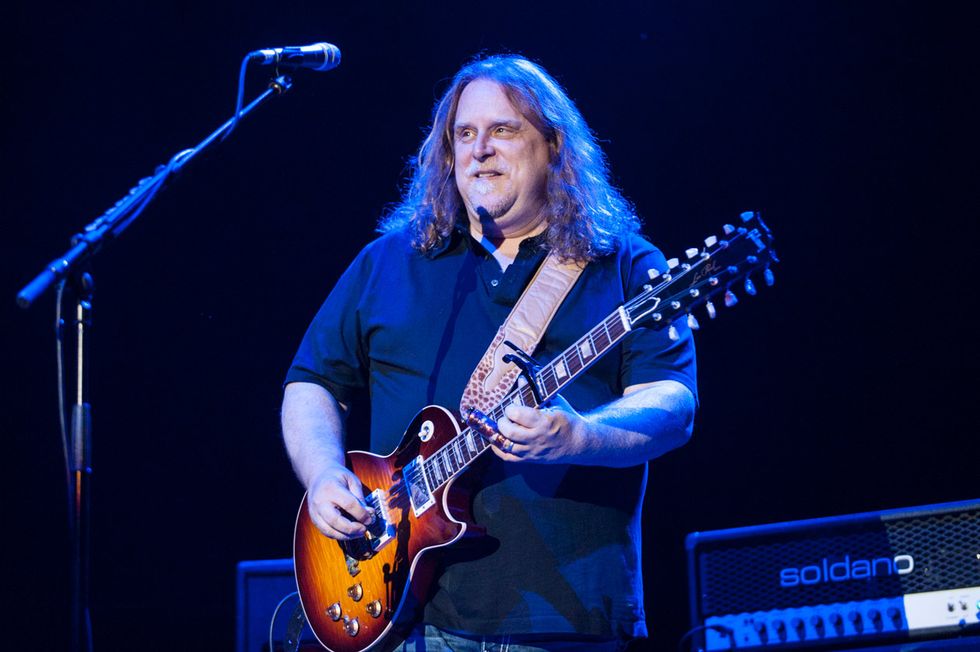
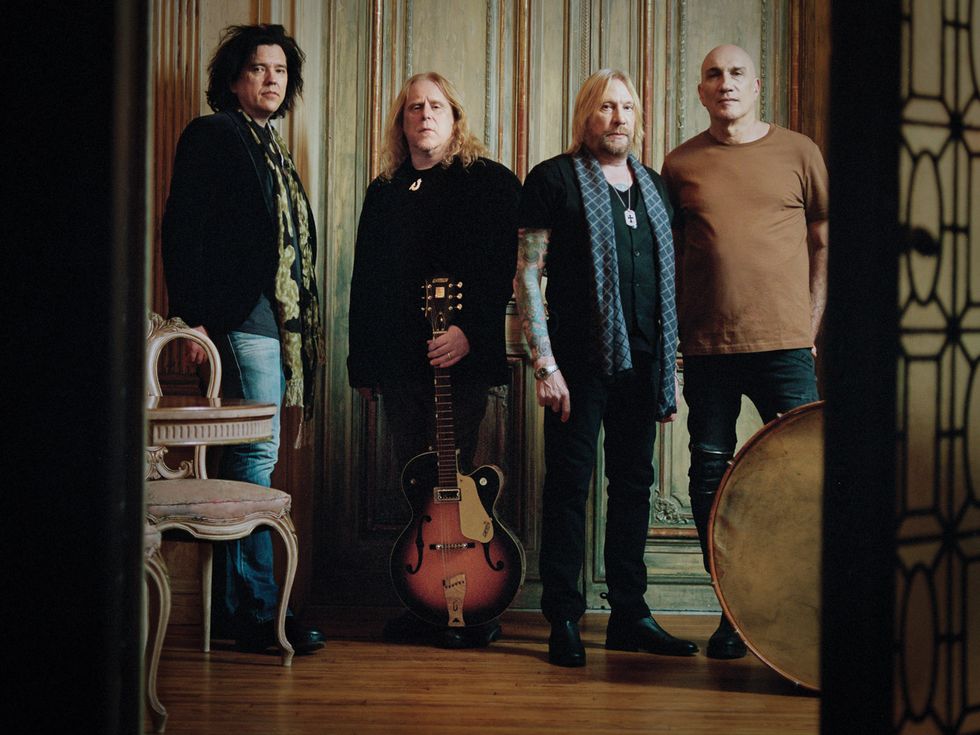
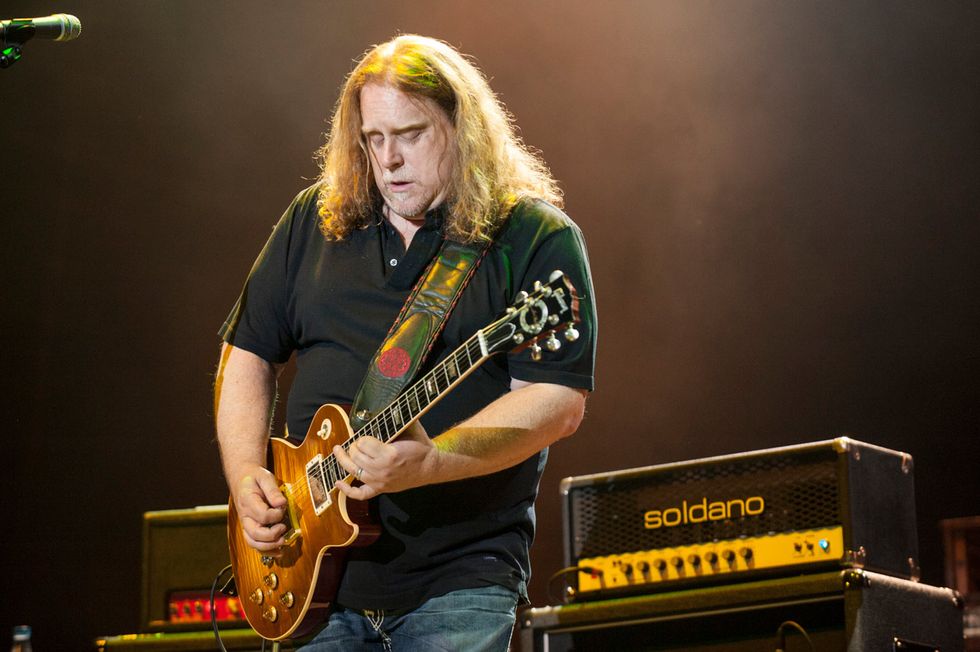
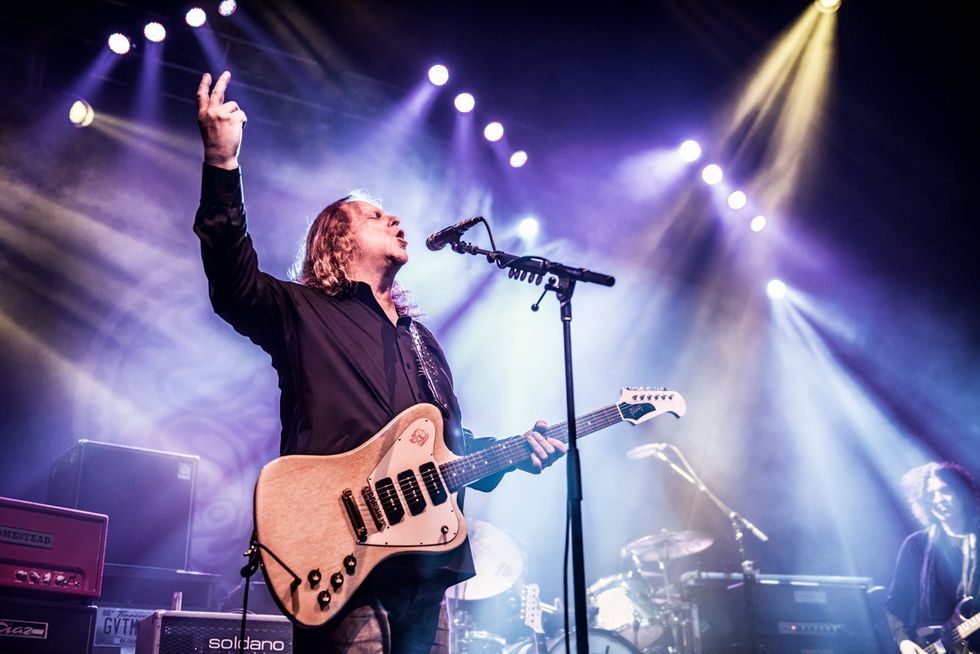








![Rig Rundown: Russian Circles’ Mike Sullivan [2025]](https://www.premierguitar.com/media-library/youtube.jpg?id=62303631&width=1245&height=700&quality=70&coordinates=0%2C0%2C0%2C0)












![Rig Rundown: AFI [2025]](https://www.premierguitar.com/media-library/youtube.jpg?id=62064741&width=1245&height=700&quality=70&coordinates=0%2C0%2C0%2C0)




















 Zach loves his Sovtek Mig 60 head, which he plays through a cab he built himself at a pipe-organ shop in Denver. Every glue joint is lined with thin leather for maximum air tightness, and it’s stocked with Celestion G12M Greenback speakers.
Zach loves his Sovtek Mig 60 head, which he plays through a cab he built himself at a pipe-organ shop in Denver. Every glue joint is lined with thin leather for maximum air tightness, and it’s stocked with Celestion G12M Greenback speakers.











